The CALP Network’s History
Conference participants annotate a CVA timeline at a Membership Launch Event in Washington DC. April 2016.
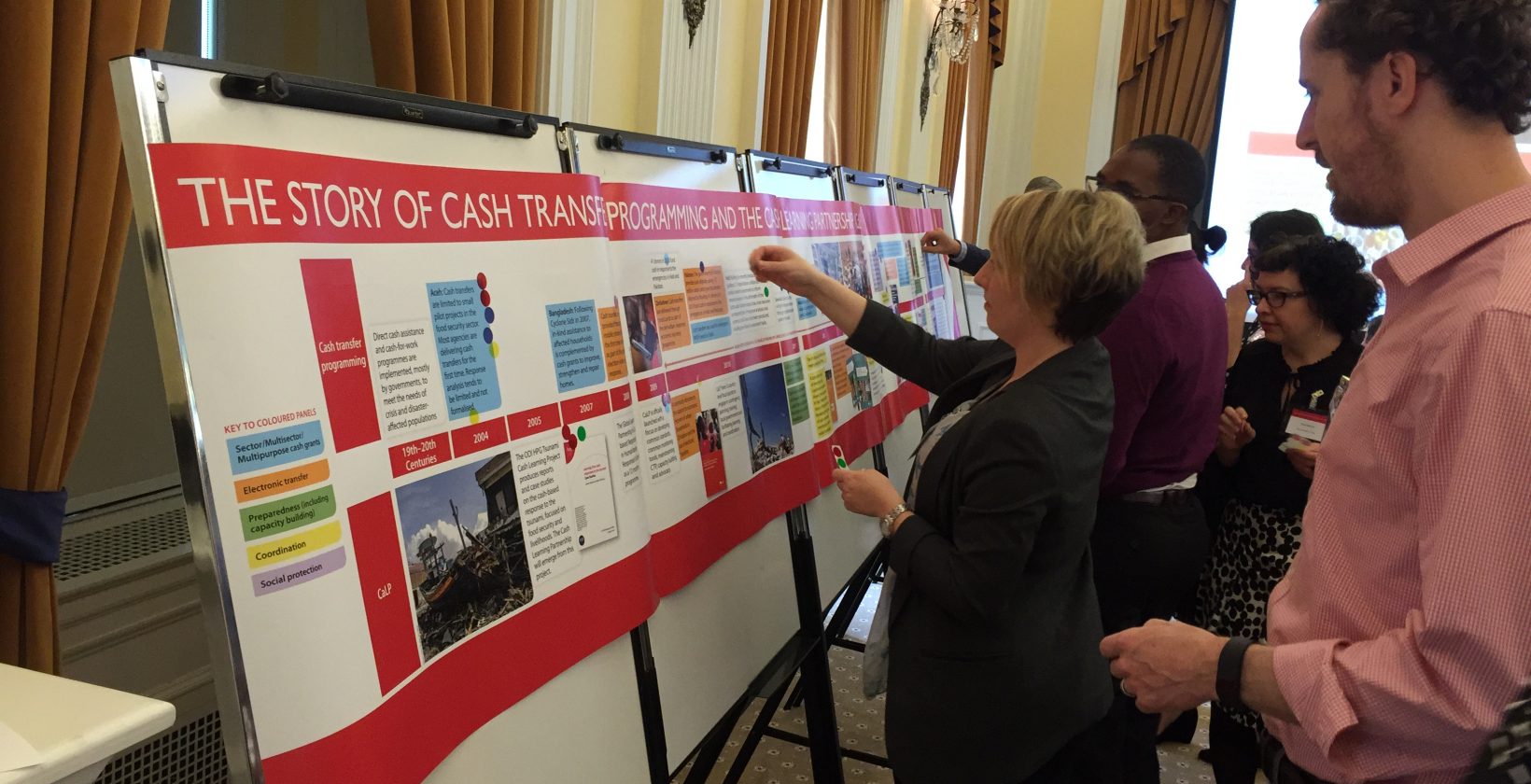
Skip to ➡️ Milestones in detail.
The short story
In 2005 a number of organisations got together to document what had been learnt about cash-based responses in the wake of the 2004 Indian Ocean Tsunami. Over time more organisations got involved and their attention shifted to the overall improvement and mainstreaming of CVA by the humanitarian sector globally.
CALP or ‘The Cash Learning Partnership’ (as it was known then) was officially launched in 2009, and started delivering training in 2011, succeeded in integrating CVA into Sphere standards in 2011, supported the formation of the first Cash Working Group (in Kenya) in 2012 and became a membership organisation in 2016. Today the CALP Network connects a vibrant network of over 90+ organisations.
The organisation was renamed the ‘CALP Network’ in November 2021 to reflect its core belief in collective action to create change.
Some selected milestones

2005 – After the Indian Ocean Tsunami, Save the Children UK, Oxfam GB, British Red Cross Society, Mercy Corps and Concern came together to promote good practice in both cash and voucher responses in countries affected by the Indian Ocean Tsunami.
2008 – The ‘Global Learning Partnership in Cash based Responses in Humanitarian Responses’ is formed as a 12-month programme by Oxfam GB, the British Red Cross Society, Save the Children UK, and then a little while later the Norwegian Refugee Council and Action Against Hunger.
2009 – ‘The Cash Learning Partnership’ is officially launched with a focus on developing common standards, common monitoring tools, mainstreaming Cash and Voucher Assistance, capacity building and advocacy. Staff are hosted by Oxfam, Action Against Hunger and the Norwegian Refugee Council.
2011 – CALP’s flagship training courses (Level 1 and Level 2) are developed and piloted in Kenya.
2011 – Cash and vouchers become a companion standard under the Food Security and Nutrition section of the Sphere Handbook.
2011 – First published in 2011, the the CALP Network Glossary is designed to facilitate a common understanding and harmonized use of terms and definitions for CVA. French, Spanish, German and Arabic glossaries were later published in 2019.
2012 – First Regional Cash Working Group meeting takes place in Kenya, mobilised by the CALP.
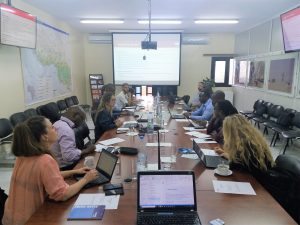
2012 – A comparative study of emergency cash coordination mechanisms drawing from case studies in Haiti, Pakistan and the Horn of Africa recommends formalising the integration of cash coordination mechanisms within the wider humanitarian system.
2014 – National Cash Working Groups were mobilsed by CALP in a number of countries. Over time, Cash Working Groups become more prevalent.
2014 – A review of cash transfer programming and the role of CALP recommends that ‘CaLP should continue with an open-ended role. It is needed and it has a substantial future role in enhancing CTP, along with others.’
2015 – CALP develops its capacity building strategy and in a single year delivers 44 training courses and learning events in 19 different countries.
2016 – Following an application round in late 2015, CALP becomes a membership organization on 1st January 2016, with 42 members. A Technical Advisory Group is established to help steer the CALP Network’s technical and policy priorities, and a Board, to have strategic oversight of the CALP Network’s work.

2017 – Global Framework for Action produced providing a consolidated summary of the major commitments and recommendations made to improve cash and voucher assistance in humanitarian response during 2015 and 2016 including the Grand Bargain.
2018 – CALP publishes the first State of the World’s Cash Report to provide a neutral and critical analysis of the current state of CVA globally.
2018 – CALP worked with Sphere to ensure the comprehensive inclusion of CVA in the new Sphere Handbook.
2019 – CALP publishes ‘The Future of Financial Assistance: An outlook to 2030’ which maps out potential scenarios for how financial assistance might develop, the key drivers influencing these changes, and what this will mean for humanitarian action.
2020 – Based on extensive consultation, CALP publishes a new strategy outlining how it will progressively activate the potential of the entire network as the primary means of achieving change.
2020 – The State of the World’s Cash 2020 is published providing a comprehensive snapshot of cash and voucher assistance, with significant recommendations for anyone interested in humanitarian action.

2021 – CALP’s flagship training course, Core CVA Skills for Programme Staff, is converted into a free online learning course available on the CALP Network’s Cash Learning Hub.
2021– As of October 2021, CALP has 95 members from across the sector, including local and international nongovernmental organisations, United Nations agencies, the Red Cross/Crescent Movement, donors, specialist social innovation, technology and financial services companies, researchers and academics, and individual practitioners.
2021 – In November CALP renames itself from ‘CaLP (The Cash Learning Partnership)’, to the ‘CALP Network’. This change reflects its core belief in collective action and in working together to transform the humanitarian system.
2022 – The CALP Network was instrumental in convening a critical mass of organisations calling for change on cash coordination. This eventually resulted in a new formal model for Cash Coordination, created by the IASC. CALP is now one of the twelve core members of the newly formed ‘Global Cash Advisory Group’, which is tasked with creating a transition plan for the implementation of the model.
2023 – The CALP Network publishes the third edition of its flagship report the State of the World’s Cash, following on from editions in 2018 and 2020. The report assessed that humanitarian cash assistance was at a crossroads, and that unlocking the potential of cash assistance to meet people’s humanitarian needs will require greater effort and change.
Milestones in detail
- 2005 – After the Indian Ocean Tsunami, Save the Children UK, Oxfam GB, British Red Cross Society, Mercy Corps and Concern came together to promote good practice in both cash and voucher responses in countries affected by the Indian Ocean Tsunami.
- 2005 – The ‘ODI HPG Tsunami Cash Learning Project’ saw the production of reports and case studies on the cash-based response to the tsunami, focused on food security and livelihoods.
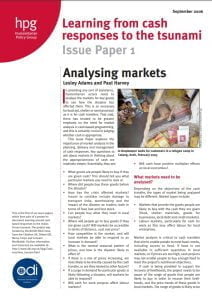
What would eventually become the Cash Learning Partnership emerged from this project.
- 2008 – The ‘Global Learning Partnership in Cash based Responses in Humanitarian Responses’ is formed as a 12-month programme by Oxfam GB, the British Red Cross Society, Save the Children UK, and then a little while later the Norwegian Refugee Council and Action Against Hunger.
- 2009 – The Cash Learning Partnership (CaLP) is officially launched with a focus on developing common standards, common monitoring tools, mainstreaming Cash and Voucher Assistance, capacity building and advocacy. Staff are hosted by Oxfam, Action Against Hunger and the Norwegian Refugee Council.
- 2010 – CALP hires 5 country level focal points to engage in contingency planning, training local governments and facilitating learning and coordination.
- 2010 – CALP opens an office in the Oxford, UK.
- 2011 – CALP opens an office for the East Africa region based in Nairobi, Kenya.
- 2012 –CALP opens an office for the West Africa region based in Dakar, Senegal.

Workshop on CVA and risks in West Africa. November 2019.
- 2014 – A review of cash transfer programming and the role of CALP recommends that ‘CaLP should continue with an open-ended role. It is needed and it has a substantial future role in enhancing CTP, along with others.’
- 2015 – A new regional office for North-America opens in Washington DC.
- 2017 – CALP opens an office for the Middle East and North Africa region based in Amman.
- 2018 – The North-America office expands to work with actors in the Latin America Caribbean region, thus becoming the Americas office.
- 2020 – Based on extensive consultation, CALP publishes a new strategy outlining how it will progressively activate the potential of the entire network as the primary means of achieving change.
- 2022 – Re-opening the Asia-Pacific office.
- 2011 – CALP’s flagship training courses (Level 1 and Level 2) are developed and piloted in Kenya.
- 2015 – CALP develops its capacity building strategy and in a single year delivers 44 training courses and learning events in 19 different countries.
- 2016 – CALP’s Level 1 training course is replaced by a new and more focused orientation course; “CVA: The Fundamentals”. It is made available both as a face-to-face training course and an e-learning course.
- 2017 – CALP launches the Cash Learning Hub on Kaya, a one-stop shop for all cash-related training and learning resources, including a wide range of new online learning on CVA. For the first time, all of CALP’s face-to-face training materials are made available for download as open-source materials.
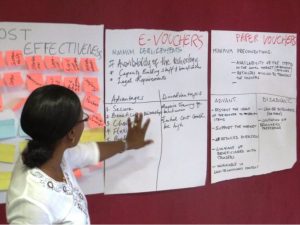
the CALP Network training in Sierra Leone, 2019. - 2018 – CALP releases, promotes and delivers its new Core CVA Skills courses targeting: programme staff, managers and operations staff. They replace the outdated Level 2 course.
- 2021 – From 2011 to the end of March 2021, 26,975 CALP e-learning courses have been completed.
- 2021 – From January 2017 to the end of March 2021, there have been 197 CALP -accredited face-to-face courses delivered, with 3,747 attendees. This level of work was only possible thanks to CALP’s cohort of 51 certified trainers and training partner organisations able to deliver the training in a variety of languages.
- 2021 – CALP’s flagship training course, Core CVA Skills for Programme Staff, is converted into a free online learning course available on the CALP Network’s Cash Learning Hub.
- 2014 – A review of cash and voucher programming and the Cash Learning Partnership recommends opening membership beyond the 5 founding members and also that a Board and Technical Advisory Group should be formed.
- 2016 – Following an application round in late 2014, CALP becomes a membership organization on 1st January 2016, with 42 members. A Technical Advisory Group is established to help steer CALP’s technical and policy priorities, and a Board, to have strategic oversight of the CALP’s work.
- 2016 – Members come together for the

First meeting of the CALP Network’s Technical Advisory Group (TAG) first time at the Membership Launch Event at the Red Cross Headquarters in April, in Washington DC, followed by the first in person meetings of the newly formed Technical Advisory Group and Board.
- 2016 –West Africa Regional Membership Event took place in December, the purpose being to build relationships and understanding amongst CALP and its members in West Africa.
- 2017 – CALP publishes a Membership Statement which outlines what it means to be a member of the CALP Network.
- 2021– as of October 2021, CALP has 95 members from across the sector, including local and international nongovernmental organisations, United Nations agencies, the Red Cross/Crescent Movement, donors, specialist social innovation, technology and financial services companies, researchers and academics, and individual practitioners.
- 2005 – CALP sets up a community of cash practitioners to connect with one another via the DGroup platform. In 2012 a group is also set up in French, and a Spanish DGroup is established in 2020.
- 2011 – First blog published – exploring new technology being used by WFP to deliver humanitarian cash transfers in Kenya.
- 2012 – First Regional Cash Working Group meeting takes place in Kenya, mobilised by CALP.
- 2014 – National Cash Working Groups mobilised by CALP in a number of countries. Over time, Cash Working Groups become more prevalent.
- 2017 – The Global Cash Forum and the CALP Network Members Day took place in Geneva in June. The forum featured discussions on operational models and scaling up cash.
- 2017 – Global Framework for Action was produced providing a consolidated summary of the major commitments and recommendations made to improve cash and voucher assistance in humanitarian response during 2015 and 2016 including the Grand Bargain.
- 2018 – Cash Week 2018 in London takes place bringing together a range of stakeholders to vision the future of humanitarian financial assistance.
- 2018 – Building on a symposium in

Gender event, Nairobi, 2018. Nairobi, the Collected papers on Gender and Cash Transfer Programmes in Humanitarian Contexts published, with a foreword by the Minister of International Development for the Government of Canada.
- 2019 – CALP starts a podcast – the ‘CashCast’ consists of interviews with experts to explore critical debates in humanitarian cash and voucher assistance.
- 2019 – Cash Week 2019 takes place in London and online, with events across the regions throughout December.
- 2020 – CALP and WFP lead the organization a series of 5 webinars, to explore the latest information and developments in the field of Minimum Expenditure Baskets. 790 people from around the globe join the sessions to learn more.
- 2012 – A comparative study of emergency cash coordination mechanisms drawing from case studies in Haiti, Pakistan and the Horn of Africa recommends formalising the integration of cash coordination mechanisms within the wider humanitarian system.
- 2014 – A review of the response to super Typhoon Haiyan documented lessons learnt on the effectiveness of cash coordination.
- 2016 – ‘The Power of Financial Aid’ website is published with the aim of becoming a go-to place for journalists seeking out information about cash and voucher assistance.
- 2018 – CALP publishes the first State of the World’s Cash Report to provide a neutral and critical analysis of the current state of CVA globally.
- 2019 – CALP publishes ‘The Future of
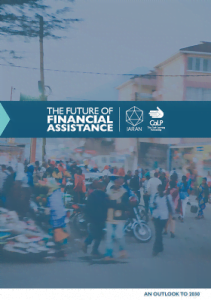
Future of Financial Assistance – Front Cover Financial Assistance: An outlook to 2030’ which maps out potential scenarios for how financial assistance might develop, the key drivers influencing these changes, and what this will mean for humanitarian action.
- 2020 – The State of the World’s Cash 2020 is published providing a comprehensive snapshot of cash and voucher assistance, with significant recommendations for anyone interested in humanitarian action.
- 2022 – The CALP Network was instrumental in convening a critical mass of organisations calling for change on cash coordination. This eventually resulted in a new formal model for Cash Coordination, created by the IASC. CALP is now one of the twelve core members of the newly formed ‘Global Cash Advisory Group’, which is tasked with creating a transition plan for the implementation of the model.2023 – The CALP Network publishes the third edition of its flagship report the State of the World’s Cash, following on from editions in 2018 and 2020. The report assessed that humanitarian cash assistance was at a crossroads, and that unlocking the potential of cash assistance to meet people’s humanitarian needs will require greater effort and change.
- 2010 – CALP publishes ‘Delivering money: cash transfer mechanisms in emergencies’ an influential paper which focusses on the practicalities of how to deliver money to beneficiaries.
- 2011 – Cash and vouchers become a companion standard under the Food Security and Nutrition section of the Sphere Handbook.
- 2011 – First published in 2011, the the CALP Network Glossary is designed to facilitate a
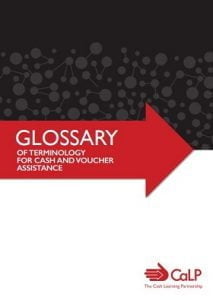
Front cover of CALP’s English Glossary common understanding and harmonized use of terms and definitions for CVA. French, Spanish, German and Arabic glossaries were later published in 2019.
- 2013 – CALP paves the way to a greater uptake of quality electronic cash transfers through an innovative series of publications related to new technologies; E-transfer guidelines; Cost-efficiency of E-transfers; and Principles and operational standards for protecting beneficiary privacy.
- 2016 – CALP’s Minimum Standard for Market Analysis was published and achieved the status of Sphere companion.
- 2016 – A guidance note for humanitarian practitioners is published on how to work link cash assistance to social protection systems in humanitarian contexts.
- 2017 – CALP launches the Programme Quality Toolbox, to support practitioners with the development, maintenance and review of quality Cash and Voucher Assistance. The toolbox makes it easy to explore and select the right industry guidance.
- 2017 – Monitoring guidance was published to support practitioners to incorporate CVA into their monitoring frameworks.
- 2018 – Guidance is developed to inform the global debate around coordination of cash transfer programming, including commissioning the Global Public Policy Institute report ‘Cash Coordination in Humanitarian Contexts’.
- 2018 – CALP worked with Sphere to
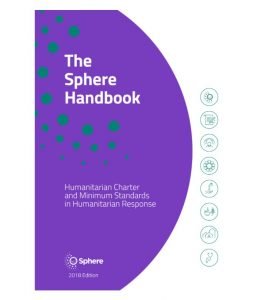
Cash was comprehensively covered in the 2018 Sphere Handbook ensure the comprehensive inclusion of CVA in the new Sphere Handbook.
- 2019 – In partnership with CALP, PHAP launched the certification in Cash and Voucher Assistance Programme, designed for humanitarian practitioners who want to demonstrate essential knowledge and skills needed by everyone working in the area of CVA.
- 2019 – A Cash Coordination Tip Sheet is produced to provide practical support to actors and help ensure effective coordination of CVA.
- 2020 – Guidance around CVA in the context of COVID-19 was created through the crowdsourcing information from across the network. The guidance was developed rapidly and published in four languages.
About
Page
In this section learn about the CALP Network, our purpose, history, staff, governance and strategy.
What We Do
Page
The potential of cash and voucher assistance (CVA) cannot be realized by organizations working alone. Since our founding in 2005, the CALP Network has been at the forefront of promoting and improving CVA across the humanitarian sector.


